We grow a rich harvest of ultra-early Solerosso tomatoes and protect them from pests and diseases
We present to your attention the unusual Dutch tomato Solerosso. The early ripeness and high productivity of the crop have been appreciated by many Russian gardeners and are rushing to stock up on seed for the next summer season in advance.
There are many lovers of early tomatoes, and early tomatoes with a delicious taste want to try everything. In addition, agricultural technology for the entire growing season is so simple that even a beginner at a summer cottage will receive a decent harvest.
Description of culture
The hybrid was bred in Holland in 2006. Judging by the description and reviews, the Solerosso f1 tomato not only successfully took root in the Russian climate, but also managed to win many fans.
Distinctive features
Bush determinant, 0.5-0.6 m high. The branches are moderately spreading, the foliage is medium, the leaves are medium-sized, dark green. The inflorescences are simple, one cluster bears up to 6 fruits.
The hybrid is early ripening, 90-95 days pass from the moment of sowing the seeds to full ripening. Due to its small growth, it is suitable for cultivation on the balcony at home.
Productivity is high, from 1 sq. m, up to 8 kg of fruits are collected, provided that 4-5 seedlings are planted per 1 sq. m. m.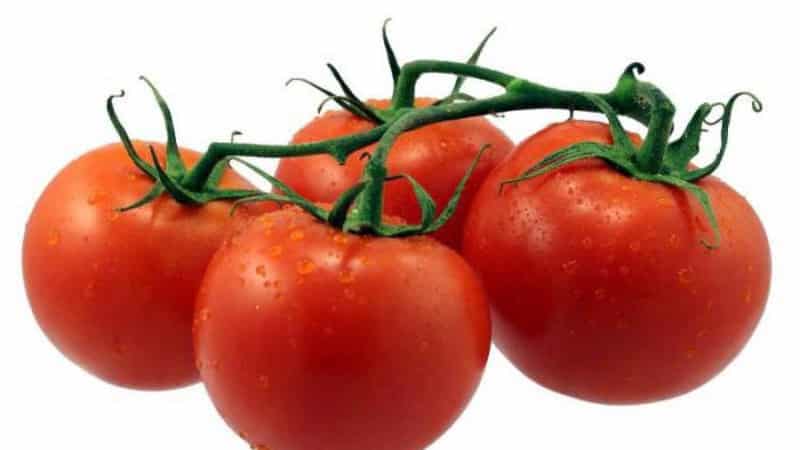
Recommended for cultivation in open ground and in greenhouse conditions.
The species is highly resistant to the main diseases of the Solanaceae family. Due to early ripening, the crop is not affected by late blight.
Plants do not require obligatory pinching, but staking, despite their small growth, is necessary. The branches, strewn with fruits, cannot withstand the weight and bend to the ground. Due to contact with wet beds, the fruits may deteriorate.
Fruit characteristics
The average weight of ripe vegetables is 120-140 g, flat-round shape, rich red color, juicy pulp, moderate density. There are 6 seed chambers. The peel is thin but durable, the taste is sweet, without sourness or wateriness.
The purpose of tomatoes is universal: they are consumed fresh, used for pickling, canning and marinades. Ripe vegetables are also processed into tomato products.
Tomatoes are subject to long-term storage and long-term transportation. Thanks to the durable peel, they retain excellent presentation for 40 days, which allows entrepreneurs to use the hybrid for commercial purposes.
The photo shows Solerosso tomatoes.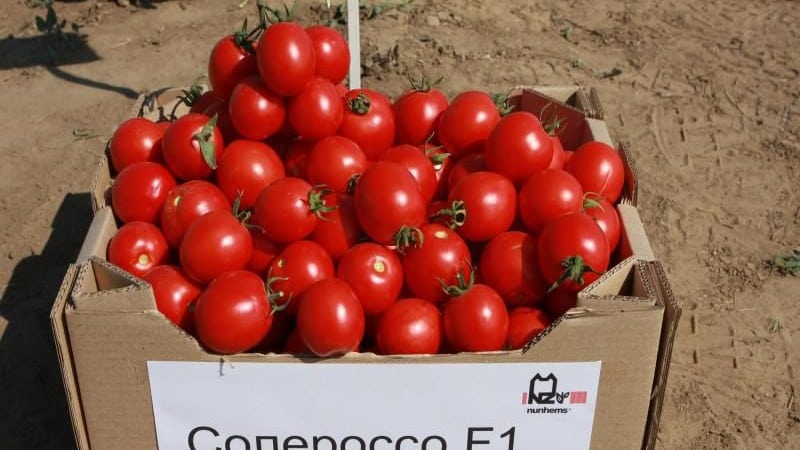
How to grow seedlings
Sowing seeds for seedlings begins 2 months before planting in the ground. As a rule, they are transplanted into a greenhouse 2 weeks earlier than into open beds. The main thing is to wait until the soil warms up to 15°C, otherwise the growth of young bushes will slow down.
Seed preparation
Since the crop is a hybrid, you won’t be able to prepare the seeds yourself - hybrids do not retain the parental genes in the next generation. Therefore, seed material will have to be purchased each time.
Purchased grains do not need processing; the manufacturer took care of everything himself. It is only necessary to assess the external condition of the planting material. To do this, lay it out on the table and carefully inspect it for visible defects: the grains should be light, without visible damage.Then check for emptiness by immersing it in a saline solution for 10 minutes.
Those seeds that float to the surface are empty inside, which means they are not suitable for planting. The remaining ones are washed with running water and dried.
Reference. To prepare a saline solution, dilute 1 teaspoon of salt in a glass of water.
To improve germination, planting material is treated with a growth stimulator and germinated on damp gauze for 2-3 days at a temperature of 25°C until sprouts appear. As the gauze dries, moisten it with warm water.
Container and soil
A nutritious soil mixture is prepared from garden soil, humus, peat and river sand in equal proportions. After thoroughly mixing all the components, add a little wood ash to the resulting mixture.
Reference. Ash enriches the sprouts with calcium and magnesium.
The prepared soil is disinfected to destroy pathogenic flora by pouring a hot solution of pink potassium permanganate. The soil is also disinfected in the oven for 15 minutes at 60°C.
After disinfection, the soil is poured halfway into the planting containers. Later, as the bushes grow, the remaining soil is poured into containers, so that the plants receive the necessary nutrients.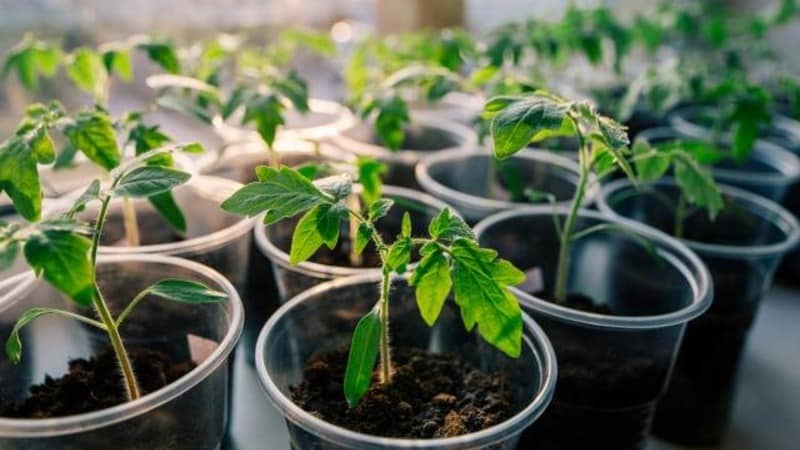
Plant in a common wooden box or in an individual container, at the bottom of which drainage holes are made so that excess moisture drains into them. Seedlings in individual containers do not need picking, so sowing in individual containers significantly simplifies the care of seedlings.
Sowing
The seeds are sown to a depth of 1.5 cm with a distance of 2 cm from each other, sprinkled with peat on top, slightly moistened with warm, settled water using a spray bottle and covered with film to create a greenhouse effect.
Then the containers are left in a warm room at a temperature of 25-26°C. At lower temperatures, the seeds will germinate later.
Seedling care
At the first shoots, the containers are moved to a well-lit place, on the windowsill, and the film is removed. Daylight hours for seedlings should be at least 12 hours. If necessary, add phytolamps.
Seedlings are watered with warm, settled water every week. After 5 true leaves appear, watering is increased to 2 times a week. After watering, the soil is loosened superficially, which helps the plants receive oxygen in the required quantity.
When 2 true leaves appear, the seedlings are picked and placed in separate containers. When picking, weak shoots are not replanted, as they will not be able to take root in open ground.
2-2.5 weeks before planting in the ground, the seedlings begin to harden, taking them outside for no more than 40 minutes. Gradually, the time spent in the open air is increased to 11-12 hours, while at the same time reducing the night temperature to 14°C.
How to grow tomatoes
After 2 months, the seedlings are transplanted into the ground. By this time, 6-7 true leaves grow on each bush, and the height of the stem reaches 25 cm.
Landing
Planting pattern: 40 cm – distance between seedlings, 50 cm left between rows.
Planted in shallow holes after sunset or on a cloudy day. After planting, the holes are watered generously with warm, settled water and the young bushes are left to adapt to the new location for 1 week.
Reference. Tomatoes are not planted in the same place every season. Good predecessors are legumes, cabbage, carrots and winter crops.
Further care for the Solerosso tomato variety
Regular watering is established once a week, maintaining this regime until flowering begins. During the flowering period, the amount of moisture consumed increases. At least 3-5 liters of water are added to each bush.
Water in the morning or evening, when there is no direct exposure to sunlight.
Reference. The amount of moisture affects fruiting rates. Prolonged drought leads to the fall of the ovaries; with excess moisture, plant growth slows down.
After each watering, the soil is loosened, hilled up and weeds with roots are removed. On dry days the beds mulch peat or straw. This helps the soil stay moist longer. In addition, mulch protects against the penetration of insect pests to the roots of plants.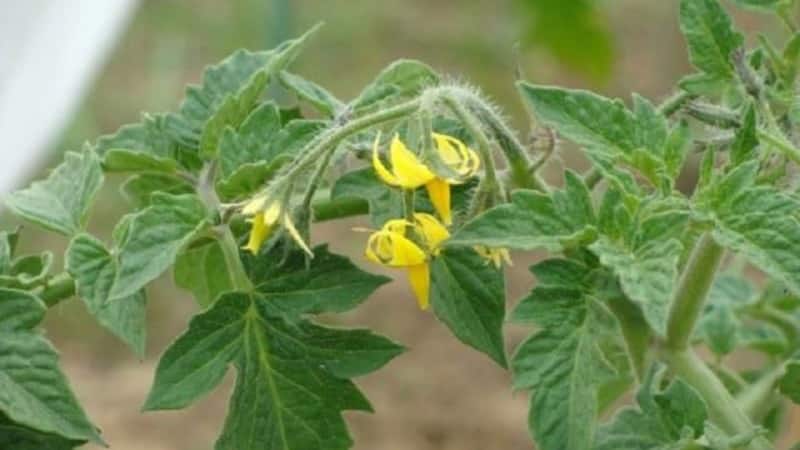
Feeding Mineral fertilizers or organic matter are used for tomatoes. The main microelements consumed are phosphorus and potassium. Potassium is responsible for taste properties, and phosphorus regulates metabolic processes necessary during the growing season.
For potassium feeding, 30 g of potassium sulfate is diluted in 10 liters of water. Fertilizer is applied at the root after watering. Superphosphate provides the plant with phosphorus. It is diluted in a proportion of 40 g per 10 liters.
Feed three times during the growing season: during flowering, during the formation of ovaries and during fruiting.
During flowering, to stimulate the ovary, a solution based on boric acid (1 g per 10 l) is added to the fertilizing.
As organic matter, mullein infusion is used in a ratio of 1:10 or wood ash, from which infusions for irrigation are prepared.
Features of cultivation and possible difficulties
The culture does not require pinching, which significantly simplifies care. But you can’t do without a garter, despite the low growth of the bushes. The support is installed next to each plant and fixed immediately upon transplantation, thereby forming a strong and even stem. Additionally, the support protects young bushes from wind and precipitation.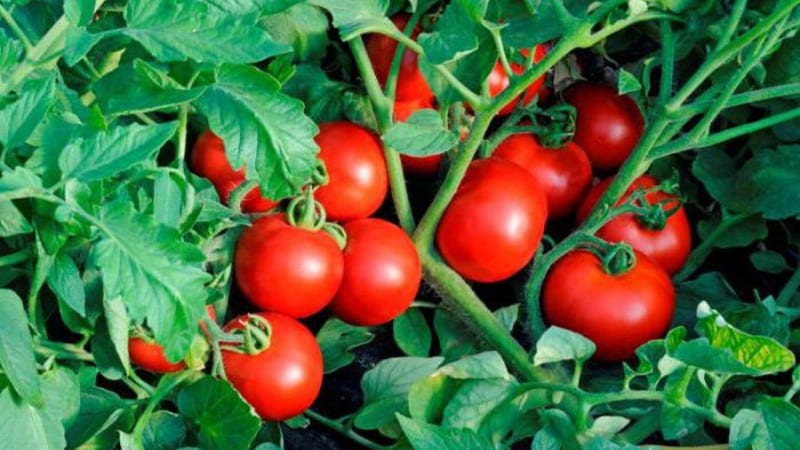
Diseases and pests
The hybrid is immune to many diseases of the nightshade family. Due to early ripening, the tomato is not subject to late blight. However, young bushes are susceptible to gray rot. Prevention from this fungal disease is frequent loosening of the soil and moderate watering without stagnant moisture in the beds. In case of infection, the drug “Fitosporin” or 1% Bordeaux mixture will help to cope with the fungus.
Among the pests that are dangerous to tomatoes are slugs, mole crickets, aphids and whiteflies. An infusion of celandine will help get rid of whiteflies and mole crickets. Aphids are afraid of the soap solution used to treat plant stems, and ammonia diluted in water fights slugs.
The nuances of breeding in open ground and in a greenhouse
Dutch culture adapts equally well to greenhouse conditions and open ground. When planting in closed structures, it is recommended to change the top layer of soil, since it is on the surface that pest larvae and pathogenic spores overwinter. Greenhouse soil is subject to mandatory disinfection.
The hybrid loves warmth, so the most productive cultivation is in regions with warm and temperate climates. When growing it in the middle zone, it is necessary to have covering material on hand in case of unexpected cold weather or prolonged rains.
Attention! The greenhouse must be regularly ventilated, since fresh air destroys the spread of fungal spores and the usual habitat of many greenhouse pests.
The hybrid adapts not only to greenhouses and open beds, it is also successfully bred on the balcony. The compact size of the bushes and simple agricultural technology make it possible to get a decent harvest even at home.
Harvesting and application
Early ripening allows you to get ripe tomatoes at the very beginning of summer. Vegetables of excellent taste are good not only for fresh consumption, but also for storing for the winter.
Fresh tomatoes are ideal in summer salads, a variety of appetizers, hot dishes and vegetable dishes such as stews or purees. Smaller tomatoes are used for pickling in their entirety. Also, tomato does not lose its taste in marinades, canned food and processed tomato products - ketchups, juices, lecho, adjika.
Ripe vegetables can be stored for a long time and can withstand long-term transportation for 40 days without losing their presentation. Entrepreneurs immediately saw this favorable factor and began to use the Solerosso tomato for commercial purposes.
Advantages and disadvantages
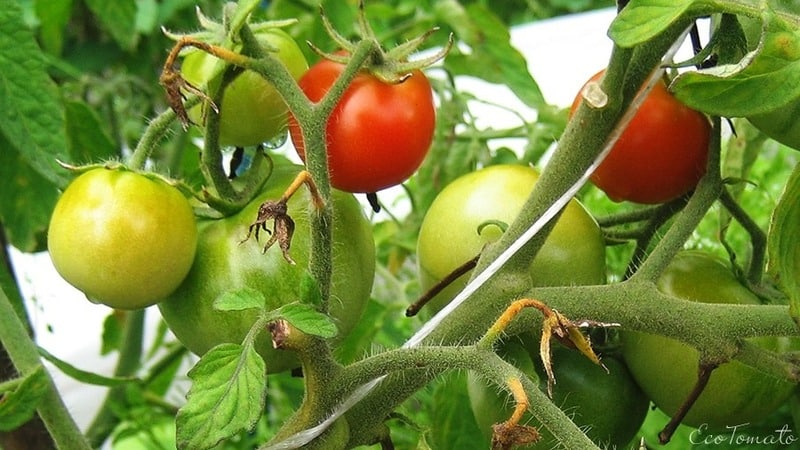
Let's start with the positive characteristics of the hybrid:
- simple agricultural technology;
- early ripening appearance;
- high adaptation to any climatic conditions;
- high fruiting rate;
- immunity to many diseases;
- does not require pinching;
- possibility of breeding at home;
- excellent taste of fruits;
- marketable condition;
- long-term storage;
- long transportation;
- universal application.
The disadvantages of the crop include the need to tie up low-growing bushes and purchase seeds for each planting.
Farmer reviews
There are no unsatisfactory reviews about the hybrid. Gardeners especially note the excellent taste and high quantitative indicator of the crop in any climatic zone.
Valentina, Chernigov: “I bought hybrid seeds last year. The fruits are well suited for canning. I used them whole, which made it possible to quickly roll up the jars. The bushes bloomed profusely, even the tops were hard to see. I didn’t tame the stepson, but tied it up, watered it and fed it. It's a pity that you have to buy seeds every time. It's good that the price is affordable."
Maria, Rostov-on-Don: “I’ve been planting a hybrid for three years now. The stem is powerful, with a large number of brushes. There are never any problems with pollination and the yield is high. I constantly treat the plantings, so I have not observed blossom end rot or other diseases. When fertilized and watered, the fruits gain up to 150 g. The taste is excellent. This tomato has become one of my favorites and a permanent inhabitant of my garden bed.”
Conclusion
The Solerosso tomato variety is excellent for cultivation both in small gardens and on an industrial scale. Perfectly adapting to any climatic conditions and requiring minimal care, the crop has long been of interest to farmers as a source of income. The long shelf life of the fruit and great demand in the market leave no doubt in choosing a tomato.
A hybrid grown in a small summer cottage also pleases gardeners with a high rate of fruiting and excellent taste, which are perfectly preserved not only in fresh vegetables, but also in winter preparations.